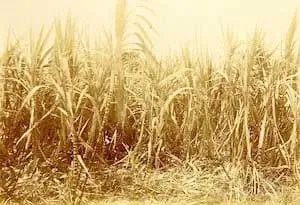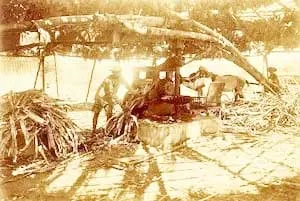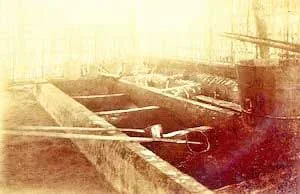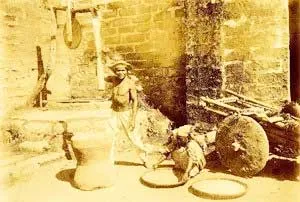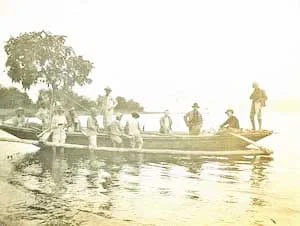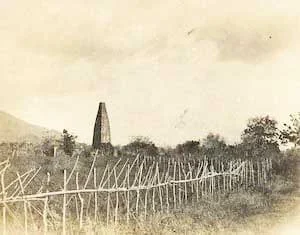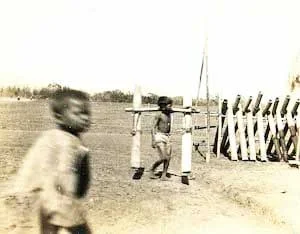Classic Photos of Bauan, Taal and Tanauan taken in the Early 1900s
In a way, photographic essays can be more descriptive than those made with words; and this one gives very graphic descriptions of life in Batangas in the early years of the American colonial era. All the pictures are taken from the University of Michigan Digital Collections. This digital collection is a rich resource of photographic content not just for Batangas but the rest of the Philippines.
To improve download time, the historical pictures contained in this page have been optimized using graphics editing software. For parties that may be interested in obtaining the highter resolution photographs, simply do a search of the University of Michigan Digital Collections and find resources related to the Philippines and, in particular, the province of Batangas.
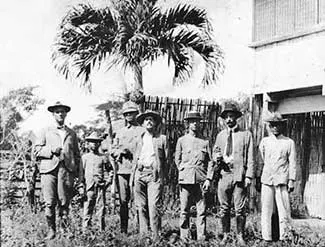 |
| Image credit: University of Michigan Digital Collections, with the title “Seven men” taken 2 January 1904 in Batangas. |
BAUAN
The image above is entitled “Nipa palms in salt marsh; near Bauan, Batangas” and was taken in March 1900, soon after the start of the American occupation of the Philippines. The image is part of the “Photographs of the Philippine Islands” Collection of the University of Michigan.
Above, a picture taken in 1900 with the title “Native salt works at Bauang [i.e. Bauan] Batangas. It is also part of the “Photographs of the Philippine Islands” Collection of the University of Michigan. Note the use of the name “Bauang,” which was handwritten on the original paper copy of the picture.
The picture above was taken on 18 March 1900 and entitled “Sugarcane ready to cut: Bauang, Batangas.” It is worth noting that many tracts of land are planted to sugar in the Alitagtag-Santa Teresita area even in the present day; and that Alitagtag used to be part of Bauan until 1909. This image is also part of the “Photographs of the Philippine Islands” Collection of the University of Michigan.
Above, a picture entitled “Exterior of a primitive sugarcane mill: Bauang, Batangas.” It was also taken on 18 March 1900 and is part of the “Photographs of the Philippine Islands” Collection of the University of Michigan. Click on the picture to enlarge it and you will see what two ponies apparently pulling the rudimentary cane cruncher around.
Above, up close inside the sugarcane mill. The picture is entitled “Cane crusher operated by native ponies: Bauang, Batangas.” It was taken 18 March 1900and is part of the “Photographs of the Philippine Islands” Collection of the University of Michigan.
Still inside the “primitive” sugarcane mill, the picture above was taken 18 March 1900 and entitled “Vats for stirring sugar to make it grain: Bauang, Batangas.” It is part of the “Photographs of the Philippine Islands” Collection of the University of Michigan.
The picture above is entitled “Loaded sugar carts: Bauang, Batangas.” It was taken 20 March 1900 and is part of the “Photographs of the Philippines Islands” Collection of the University of Michigan. Note the resting carabao or water buffalo waiting to be hooked onto one of the carts.
The picture above was taken in 1900 and entitled “Man pounding rice: Bauang, Batangas.” It is part of the “Photographs of the Philippine Islands” Collection of the University of Michigan. Note the woman squatting beside the man with a bilao (a flat woven container) who was likely helping the man with the pagtatahip or the process of removing the rice from the chaff or husk.
Taal
The picture above is entitled “The great church at Taal, Batangas.” It is part of the “Everett Thompson Photograph Collection” of the University of Michigan. No definitive date is given when the picture was taken, but it was 1930 or earlier. Note the formal attire of the few churchgoers caught in the picture.
The picture above is entitled “The view from the tower of the church in Taal, overlooking the city and Balayan Bay.” Note that Taal up to the present day has remained a municipality. The said picture is part of the “Everett Thompson Photographic Collection” of the University of Michigan and was taken anytime between 1900 and 1930.
Above, a picture entitled “Our banca on the beach of the Volcano Island, just setting out for Taal.” The picture was likely taken after an expedition to explore Volcano Island inside Taal Lake and the group above was on the return trip to the shores of San Nicolas, which at the time was still a barrio of Taal. The picture was part of the “Everett Thompson Photograph Collection” of the University of Michigan and was supposed to have been taken after the great 1911 eruption of Taal Volcano.
TANAUAN AND SANTO TOMAS
The picture above is entitled “Tanauan school-children, Batangas: a bunch of blackberries,” decidedly racist in the present day but probably perfectly normal in the context of the era when the picture was taken. It is part of the “Everett Photograph Collection” of the University of Michigan and taken between 1900 and 1930.
The picture above is entitled “All that remains standing – the chimney of an old sugar mill, destroyed many years ago: near Santo Tomás, Batangas.” The photograph is part of the “Everett Photograph Collection” of the University of Michigan and was taken anytime between 1900 and 1930.
Above, a picture entitled “The cuartel and plaza: Tanauan, Batangas,” cuartel being military barracks in Spanish-speaking countries, which the Philippines were in the era when the picture was taken. Hence, the soldiers in formation included in the picture. This is part of the “Everett Thompson Photograph Collection” of the University of Michigan and was taken between 1900 and 1930.
The picture above is entitled “Church and convent: Tanauan, Batangas” and is part of the “Everett Thompson Photograph Collection” of the University of Michigan. The picture was taken between 1900 and1930.
Above, a picture entitled “On the highway: near Tanauan, Batangas.” The use of the word ‘highway’ is almost amusing because in the photograph is no more than a dirt road; but this must have been in an era when the Americans had already undertaken the construction of roads all around the archipelago. The picture is part of the “Everett Thompson Photograph Collection” of the University of Michigan and taken between 1900 and 1930.
The title of the picture above is “Reconcentration camp: Tanauan, Batangas.” This was undoubtedly one of the concentration camps set up around the province on orders from General J. Franklin Bell late in 1901 to prevent the civilian population from supporting the troops of General Miguel Malvar. The picture is part of the “Everett Thompson Photograph Collection” of the University of Michigan. Although no definitive date is given when the picture was taken, it is safe to assume that it was likely not long after the end of the Philippine-American War in 1902.
Above, a picture entitled “Normal School at Tanauan, Batangas,” a normal school being a school or college for the training of teachers. The picture is part of the “Everett Thompson Photograph Collection” of the University of Michigan and was taken between 1900 and 1930.
Finally, the picture above is curiously entitled “Municipal Fire Department of Tanauan, Batangas.” It looks anything but a fire department, and if anyone knows what the bamboo poles are for, do say what they are in the comments section below. The picture is part of the “Everett Thompson Photograph Collection” of the University of Michigan and taken between 1900 and 1930.
Notes and references:
All images in this page were taken from the University of Michigan Digital Collections.



